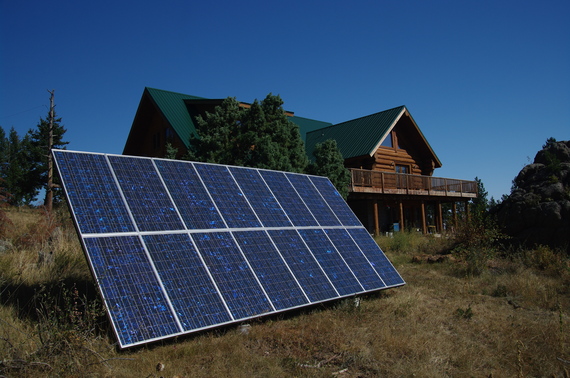
"We've had numerous problems recently with Southern California Edison refusing to allow our customers to use their solar power systems, all because the utility says they have no proof that the stored energy came from renewable sources," Cecilia Villaseñor Johnson, co-owner of Santa Barbara, CA-based solar installer Sun Pacific Solar Electric told me. "These systems have already been inspected and have signed permits, but five months have passed and our customers are still not allowed to turn them on. The utility is also refusing to allow some of our clients to expand their current systems, and even threatening to shut existing systems down entirely."
That assertion by California investor-owned utilities (IOUs) Pacific Gas and Electric and Southern California Edison is that modern battery backup solar power systems have somehow changed the game to make selling excess generated energy back to the utility profitable for consumers. That couldn't be further from the truth, said Phil Undercuffler, Director of Product Management and Strategy at Outback Power Technologies, a US manufacturer of grid-interactive solar energy products.
"Grid-tied battery backup systems are as old as the earliest days of grid-connected solar, and there's no good reason for this new logjam facing both homeowners and solar professionals," Undercuffler said. "All of those early installations were battery-based, and most are still in operation. The utility claim that systems have changed recently is not true. And the IOU's fear of and long-time disagreement with Federal and State net energy metering (NEM) standards is no secret."
Fortunately, some sanity has been restored to the controversy in California with a recent Assigned Commissioner Ruling (ACR) by the California Public Utilities Commission. In short, it states that for the next two years all systems with battery storage would qualify as renewable generating facilities and therefore be exempt from the extra fees and charges involved when classified as non-renewable because of battery storage. Customers would still have to pay for special metering--at an extra installed cost of about $1,400--to assuage the fear of energy arbitrage, but the ruling even leaves open the possibility that systems in areas that have no time-of-use rate tiers could be exempt from that requirement.
"The new California ACR is a wonderful thing for the solar industry, as it gives clarity to both the utilities and the solar industry on how to address the issue," Undercuffler told me. "There are still a few problems that need more guidance, but this is a great opportunity for the utilities and the solar industry to come together and work out the actual intent and usage of solar energy storage systems. At the end of the day, these systems will benefit both consumers and utilities."
Carrie Hitt, Senior Vice President of State Affairs for the Solar Energy Industries Association, a solar industry advocacy group, said "From our perspective, if the storage system meets the criteria of "addition or enhancement" to the NEM system then, by statute, it is a NEM-eligible facility and the same rules should be applicable without a sunset date."
That's the sort of straight talk that both homeowners and renewable energy professionals welcome. But, will other utilities in other states pick up this "straw man" tactic and start to use these same invalid arguments? That's a big fear in the renewables industry at this time for both professionals and consumers, though the problem is currently getting media notice only in California.
"The NEM standard is under attack right now in many regions," Undercuffler said. "There's more and more utility disincentive for consumers to go renewable. That's a shame--it should be the opposite."
Do the math, please
I've been designing and installing battery-based solar and wind power systems for my clients since 1994. And perhaps the most common question I hear is "can I just install batteries and tell the electric utility to cut me off so I can save money?" My answer is always no; the grid is the most high-tech, reliable and inexpensive "battery" every made, and all it takes to install effective battery backup in case of rare grid blackouts is a "critical loads subpanel" and possibly a backup generator for more extended outages after a major natural disaster.
A typical "battery bill" for a backup system can easily run from $30 per month to well over $120--it's simply the up-front cost of the batteries and associated equipment amortized over the expected lifespan, which ranges from only six to ten years for batteries. That puts the cost of a battery-stored kilowatt-hour (kWh) of energy anywhere from 40 cents per kWh up to a dollar--far higher than any rate paid by any utility in America to homeowners who generate more energy than they use each month. According to the US Energy Information Adminstration, the US average electric rate is only about 11 cents per kWh, and the tiered rates paid by Southern California Edison don't even come close to 40 cents.Even with a favorable tiered time-of-use rate, there's no way for a consumer to make money from a utility that way.
Battery backup systems are designed for energy security, not profit. It would certainly be possible to program them to sell power to utility directly from the battery bank, but such a decision by an installer or consumer would be financially foolish thanks to that monthly "battery bill." I can't wear rose-colored glasses for this grim financial math. That would result in disillusioned customers tracking me down bearing flaming torches---their only source of light thanks to ruined battery banks powering ill-designed and mis-programmed systems.
Battery backup simply doesn't work that way, financially or technically. The batteries are integrated to sit there, unused but under a minimal "float charge" from either renewable or grid power until the utility drops the ball and a blackout occurs, and then to run critical loads until grid power is restored. In many more rural areas that happens all too frequently, and lives are at stake when medical equipment is involved, not to mention freezers full of food. When a solar array is making more energy than is being consumed by the household, then (and only then) does the system sell energy back to the utility.
For utilities to blame consumers or renewable energy installers of trying to profit from these systems indicates either ignorance of the technical and financial issues involved--or, more likely, yet another utility tactic born out of the fear of a future that minimizes coal, gas and nuclear electricity generation in favor of distributed renewable energy sources owned by consumers, not corporations.
